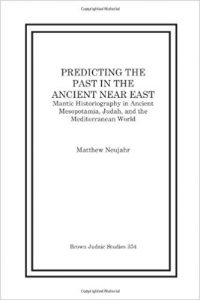Ler os textos proféticos não é a mesma coisa que ouvir os profetas de carne e osso.
Entre as tendências recentes mais importantes no estudo da profecia israelita antiga está o reconhecimento de que o fenômeno social do profetismo deve ser entendido como algo bastante distinto dos textos literários dos quais coletamos nossos dados sobre as atividades proféticas. Ou, para afirmar o problema em seus termos mais básicos: os textos não são profetas. Estudar um texto é uma tarefa literária e não é o equivalente de um trabalho de campo antropológico no qual o sujeito humano pode ser observado em primeira mão.
Além disso, parece altamente provável que textos que contenham referências às atividades de figuras proféticas não tenham sido eles próprios escritos pelos profetas cujas palavras pretendem conter. Portanto, ao tratar textos que pretendem relacionar casos de atividade profética ou práticas mânticas de maneira mais ampla, é imperativo manter pelo menos um olho nos processos pelos quais a atividade mântica foi registrada em forma literária, bem como as motivações para fazê-lo. Ou seja, os processos de escrita devem ser considerados ao se estudar esses textos. Oráculos proféticos podem ter sido compostos e proferidos por figuras proféticas, mas os textos proféticos são obra dos escribas.
cujas palavras pretendem conter. Portanto, ao tratar textos que pretendem relacionar casos de atividade profética ou práticas mânticas de maneira mais ampla, é imperativo manter pelo menos um olho nos processos pelos quais a atividade mântica foi registrada em forma literária, bem como as motivações para fazê-lo. Ou seja, os processos de escrita devem ser considerados ao se estudar esses textos. Oráculos proféticos podem ter sido compostos e proferidos por figuras proféticas, mas os textos proféticos são obra dos escribas.
Among the more important recent trends in the study of ancient prophecy is the recognition that the social phenomenon of prophetism must be understood as something quite distinct from the literary remains from which we cull our data concerning prophetic activities. Or, to state the problem in its most basic terms: texts are not prophets. To study a text is a literary endeavor and is not the equivalent of anthropological fieldwork in which the human subject can be observed first hand. Furthermore, it seems highly likely that texts which contain references to the activities of prophetic figures were not themselves written by the prophets whose words they purport to contain. Therefore, in treating texts that purport to relate instances of prophetic activity, or mantic practices more broadly, it is imperative to keep at least one eye on the processes by which mantic activity was recorded in literary form, as well as the motivations for doing so. That is to say, the processes of scribalization must be considered when studying such texts. Prophetic oracles may have been composed and delivered by prophetic figures, but prophetic texts are the work of scribes.
Referência
NEUJAHR, M. Predicting the Past in the Ancient Near East: Mantic Historiography in Ancient Mesopotamia, Judah, and the Mediterranean World. Atlanta: SBL, 2012, p. 3-4.
Matthew Neujahr is a Resident Scholar at Marquette University, Milwaukee, WI, USA.